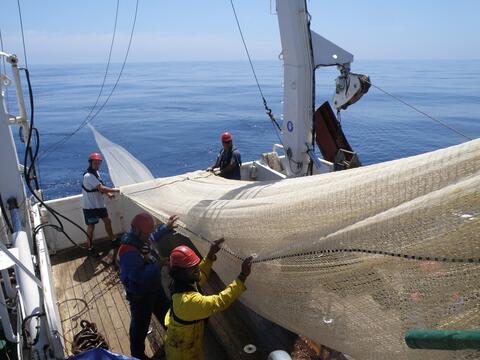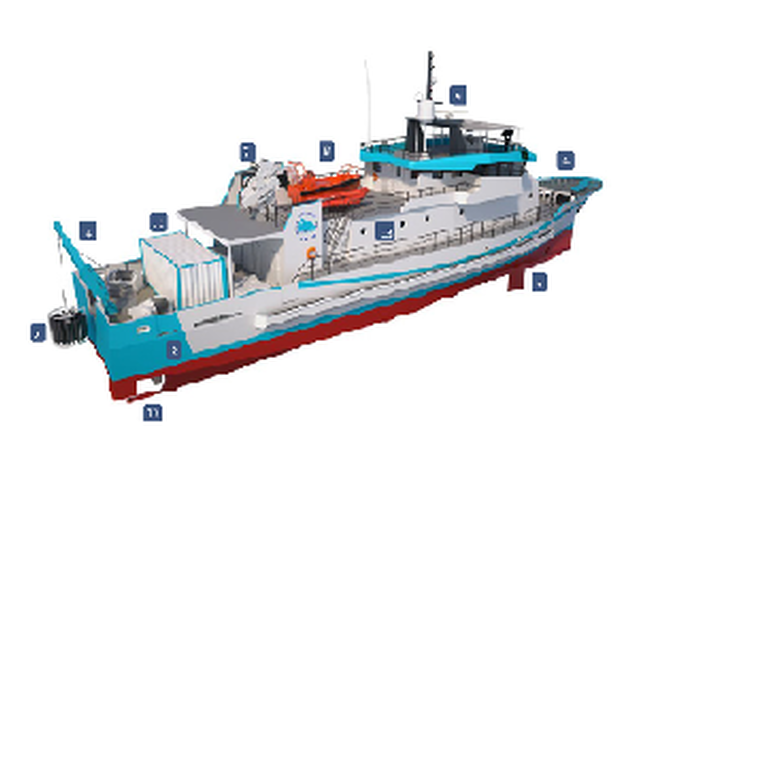Delivering the oceanic science for evidence-based decisions to protect and preserve Pacific marine resources
Tuna is a highly valuable resource in the Pacific; for many Pacific Islands, tuna fishing is the main financial asset. Understanding the biology and ecology of a species, such as tuna, is essential to being able to fish it in a sustainable way to preserve this resource for the future. The work we carry out on board the research vessels contributes to global knowledge about this species. We study the diet as well as the environment in which these fish live – such as the current, temperature, and salinity – collecting data on board the vessels which will be analysed once back on land.
FAME’s scientific cruises began back in 2011 in collaboration with the French Institute of Research for Development (IRD). Initially, the cruises focused on New Caledonia’s exclusive economic zone (EEZ), where the IRD research vessel Alis is based, with 13 cruises (2011-2021) lasting between three days and three weeks. The work was later extended to other EEZs and high sea areas with a cruise in 2018 in Wallis and Futuna and in Solomon Islands and Federated States of Micronesia in 2021. We have also collaborated with other institutions, such as the University of Tokyo for long cruises across the South Pacific (2013, 2016), and with the National Oceanic and Atmospheric Administration (NOAA) for work around Samoa (2016). The goal of these cruises is to acquire new knowledge on the offshore pelagic system where tuna live. This allows us to better understand the ocean, its inhabitants, and how it functions so that we can better forecast tuna movements and develop appropriate management measures to maintain an optimal and sustainable fish stock.
The research cruises, on the research vessel ALIS, are multidisciplinary, bringing together a small group of around six scientists who are responsible for collecting data for the physico-chemical characterisation of the ocean (such as currents, temperature, salinity, oxygen, nutrients, primary production) as well as biological data (phytoplankton, zooplankton, and micronekton). There is typically a crew of around 12 people also onboard the vessel, which is equipped with the following technology:
- Micronekton trawl net - to collect specimens of fish, squid, shrimps, gelatinous organisms which make up the micronekton
- CTD rosette - a water sampler with a probe for the analysis of temperature, salinity, light, fluorescence, oxygen etc.
- HYDRO-BIOS zooplankton net - to collect samples of zooplankton
- TRACOR Acoustic Profiling System (TAPS) - an acoustic instrument for profiling zooplankton
- SIMRAD Wide-Band Autonomous Transceiver (WBAT) - an acoustic instrument to collect micronekton data
- Thermosalinograph - to record salinity and sea surface temperature along the cruise track in real time
- S-ADCP - to estimate the speed of marine currents
- SIMRAD EK60 - echo sounders dedicated to observing the water column and recording the density of micronekton in the water column

The scientific cruise leader chooses the sampling stations according to the scientific questions to be answered. For example, in New Caledonia, where we have conducted many cruises, we have explored the area spatially to collect samples in all corners of the EEZ to observe spatial changes. We also repeated sampling in the same areas during different seasons to look at changes according to seasons. In Wallis and Futuna, on the other hand, we had a special interest in seamounts and so we included several of these in the sampling station plan.
At each station, we usually perform several different experiments to collect samples and electronic data. In addition to this, we carry out one to two fishing operations for micronekton using a trawl net. We take water samples, in the trawl cod end, for genetic analysis of environmental DNA, which allows us to learn which large families, which genera or, if possible, which species of micronekton passed through this water. We sort all the specimens caught into large groups. All these samples, along with the specimens, are placed in the -20°C freezer onboard the boat for subsequent analysis at the SPC laboratory.

